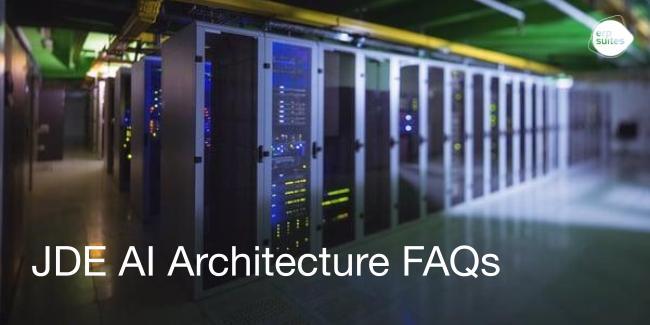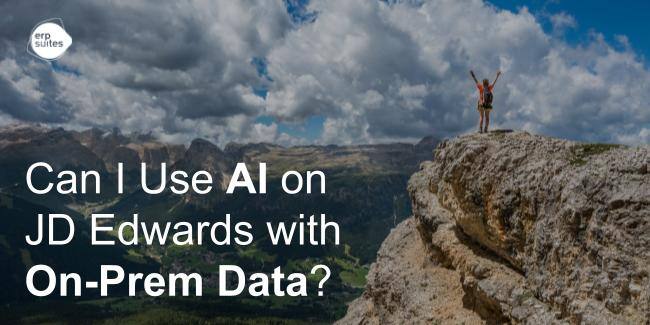How a JD Edwards Application Upgrade Works - And Why You Need One
November 22nd, 2023
3 min read

Like any software, JD Edwards requires regular maintenance and updates for optimal performance and security. An application upgrade is part of that fine-tuning process. This article explains the technical details of a JD Edwards application upgrade: what it entails, how it works, why it’s crucial, and the sizeable impact it can have on your business.
What Is an Application Upgrade
An application upgrade refers to the multi-step process of transitioning software from one version to a newer iteration. Within the function of JD Edwards are objects, which can be anything from a table, a form, a definition, a business function, and so forth. These objects comprise the application, and the objects are what are transformed during the upgrade.
Customizations
Objects can be modified by the customer via customization, and often are. As a result, if a customer has modified anything that is an out-of-the-box object when they take the application upgrade, these objects will need to be retrofitted.
Steps to Upgrade
The main steps to undertaking an application upgrade necessitate working within various JD Edwards environments to ensure all pieces of the process work together harmoniously. The upgrade occurs within each environment and then is graduated throughout.
DV environment
The first step of the upgrade is performed in the DV, or development environment. Within this environment, the developer team observes the code of the objects to compare and identify any changes that have been made. From there, they retrofit as necessary the previously created customizations. This ensures the company continues to operate with the desired tools at hand.
PY environment
After everything has been retrofitted in the development environment, the objects are promoted into the PY environment, or Prototype environment. For an application team, this is where user acceptance testing is performed. Business users are brought in to run their business processes to be sure nothing is broken.
Frequently, customers don’t have an existing script in hand to run through these tests, so it’s imperative that a test plan has been developed prior to the upgrade process.
Production environment and “go live”
Once testing has been completed and verified, a cutover is performed, promoting all the upgraded code into the PD environment, or production environment. Here, a package is built with all the code updates to deploy to all the servers and be sure that everything is aligned. More testing is typically done in this environment – a sanity check – to confirm everything is running as it should before the update goes live.
After this final round of testing confirms the upgrade is successful, it goes live, and the business starts using the upgrade application.
Application upgrade cadence
An application upgrade is included in the electronic software update, or ESU. These are generally released monthly and a business can apply them as desired if they’re addressing something that they need. If a business opts to select all the ESUs, that in and of itself constitutes a complete upgrade. The scope for your upgrade is essentially determined by what you have and have not taken in the form of an ESU or update.
32-bit versus 64-bit
Servers operate on 64-bit processing architecture. Not all applications have been recompiled to take advantage of 64-bit, but JD Edwards is effectively discontinuing the 32-bit code set in the most recent update level. 64-bit is tied to the foundation and requires a recompilation of the application objects. In release 23, the upgrade includes both the applications and the foundation together.
It has been possible in the history of JD Edwards to incrementally upgrade your foundation without touching your applications. At certain points though, the two must be upgraded together because of things like 64-bit processing. JD Edwards is doing away with the separate delivery of tools or foundation code and applications – the two are being bundled together moving forward. This is being done for various reasons. Primarily, it is easier for JD Edwards to manage the delivery of the packaged elements in a single release.
This process of conversion can be complicated and is typically an unknown change for most customers. It is advised to speak with your JDE partner to be sure your upgrade is achieved in the most compatible and seamless way possible.
Application upgrade and foundation
An application upgrade can make a world of difference for your business. It’s important to carefully plan out the process and lay out your goals before proceeding with an upgrade. For example, if you are thinking of taking an upgrade to access new features, you want to be sure you:
- Make use of those new features,
- Can implement them successfully and
- Train your team to implement and execute.
Take the first step to harness the full power of your ERP by dropping us a line here.
Leyla Shokoohe is an award-winning journalist with over a decade of experience, specializing in workplace and journalistic storytelling and marketing. As content manager at ERP Suites, she writes articles that help customers understand every step of their individual ERP journey.
Topics:



.png?width=650&height=325&name=Blog%20Images%202_1%20(4).png)
.png?width=650&height=325&name=Blog%20Images%202_1%20(5).png)
.png?width=650&height=325&name=Blog%20Images%202_1%20(3).png)
.png?width=650&height=325&name=Blog%20Images%202_1%20(2).png)
.png?width=650&height=325&name=Blog%20Images%202_1%20(1).png)
.png?width=960&height=540&name=Blog%20Images%20(96).png)

.png?width=960&height=540&name=Blog%20Images%20(90).png)
.png?width=960&height=540&name=Blog%20Images%20(88).png)
.png?width=960&height=540&name=Blog%20Images%20(87).png)
.png?width=960&height=540&name=Blog%20Images%20(86).png)
.png?width=960&height=540&name=Blog%20Images%20(85).png)
.png?width=960&height=540&name=Blog%20Images%20(83).png)
.png?width=960&height=540&name=Blog%20Images%20(82).png)
.png?width=960&height=540&name=Blog%20Images%20(80).png)